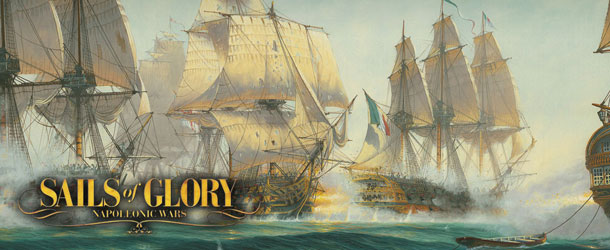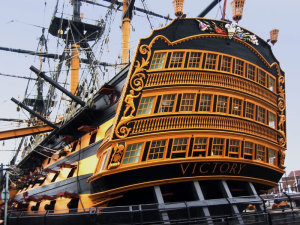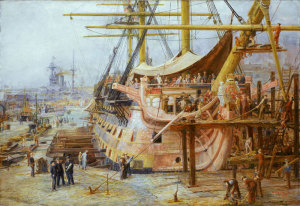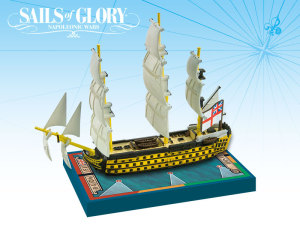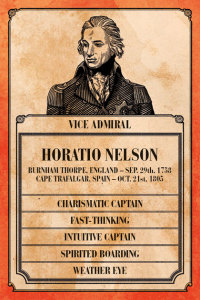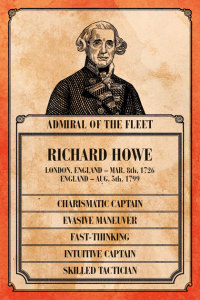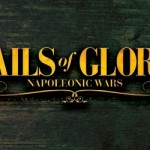Two of the most famous ships of Napoleonic Wars, which have been eagerly awaited by Sails of Glory players, are arriving in the first Special Ship Packs: the British HMS Victory 1765 (1805) and the US USS Constitution 1797 (1812). In this article, we'll learn more about the HMS Victory, the Three-Deck First Rate 100-gun Flagship for Lord Nelson’s at Trafalgar in 1805.
The HMS Victory 1765 was the fifth to bear the name in the Royal Navy and the 13th British First Rate. Only 34 ships of this class were built in British naval history, as they were very expensive to build, man, and maintain. But, on the other hand, their size made them impressive; as flagships they could accommodate a fleet Admiral and his staff, and they were able to engage any other ship afloat. Laid down in 1759 and launched in 1765, this version of the Victory was designed by Sir Thomas Slade with lines based on the Royal George of 1756.
With an overall lenght of 69 meters, a beam of 15.7 meters and a draught of 8.7 meters, the HMS Victory’s displacement was around 3500 tons. It could reach a speed of 8 to 9 knots. Despite the impressive size and First Rate ships' reputation of being hard to handle and slow to respond, she was nimble for her size and capable of keeping up with smaller ships. She was designed to carry at least 100 guns and was established with that number; in practice, her armament varied from 104 to 106 guns and carronades. The crew was about 850 men (although, at Trafalgar it was 821 men).
Victory was built at Chatham Dockyard. Once her frame was completed, she was left to ‘season’ – a process usually taking six to twelve months. In Victory's case, however, it lasted nearly three years, as the work restarted only after the Seven Years War ended. When she was launched, on 7 May 1765, she was bound not for war, but the reserve fleet. Not until 1778 was she commissioned for sea service, as the flagship of the main fleet under command of Admiral August Keppel, during the American War of Independence.
On 27 July, Victory saw her first action at the Battle of Ushant, when the Keppel’s fleet of 30 ships engaged a French force of 29 ships. The French Admiral had orders to avoid battle, so the fight was brief and inconclusive. Both fleets had minor damage, and Victory returned to Plymouth for a short repair and then returned to service in the Channel fleet. In December 1781, as the flagship of Vice Admiral Richard Kempenfelt, HMS Victory took part at the Second Battle of Ushant. The British Fleet of 12 Ships of the Line intercepted a French convoy and captured 15 transport ships, 1000 soldiers, and 550 seamen.
The Battle of Cape Spartel, on 20 October 1782, was Victory's final engagement in the American War for Independence, serving Admiral Richard Howe. After successfully resupplying Gibraltar for the third time in the course of the three-year-long Great Siege, the British fleet of 35 ships met a Franco-Spanish force of 38 Ships of the Line. With orders of return home and avoid fighting in straits, the British succeeded in retreating, so the battle was indecisive.
In February 1797, Victory was Admiral Sir John Jarvis’ flagship when his fleet of 15 ships engaged a Spanish fleet of 27 Ships of the Line under Admiral Don José di Córdoba y Ramos, near Cape St. Vincent. Jarvis’ fleet defeated the larger enemy, thanks to highly disciplined and the efficient British gunnery (compared to an inexperienced Spanish navy under Don José Córdoba) and the bravery of Commodore Horatio Nelson.
The Spanish were caught by surprise, sailing in two divisions, and Jervis planned to exploit the situation, destroying one division before the other could come to its assistance. But, when he realized the enemy fleet could close up before his fleet would be able to turn and get into action, he ordered his ships to change course. The leader of rear division failed to comply the order, but, the commander of a Third-Rate, Captain Nelson, hauled out of line and attacked the head of the second Spanish division. He held the two Spanish squadrons apart, at one time fighting seven enemy ships, while the rest of the fleet turned to come in support, ultimately capturing two Spanish vessels.
But, the most famous battle in which Victory took part was Battle of Trafalgar, when she was Vice-Admiral Nelson’s flagship, on 21 October 1805. After two years out of service, Victory underwent three years of extensive reconstruction, and in May 1803 she was sailing again under the command of Nelson.
The Battle of Trafalgar was one of the most decisive naval victories of the war. Due to Nelson’s tactics, 27 British Ships of the Line soundly defeated the combined French and Spanish fleet of 33 Ships of the Line. Instead of engaging the enemy fleet in a single line of battle parallel to the enemy, Nelson divided his smaller force into two columns directed perpendicularly against the larger enemy fleet. The results were decisive. The enemy lost 22 ships, while the Royal Navy did not lose a single one. Nelson, however, was mortally wounded during the battle )shot at the height of the engagement) and died on Victory’s orlop deck after receiving news of victory.
In 1808, Victory was re-commissioned to lead the fleet in the Baltic, but four years later her active career ended. and she was relegated to harbor service - serving as a residence, flagship and tender providing accommodation. In 1824 she began serving as a harbor ship. In 1922 she was moved to a dry dock at Portsmouth, England, and preserved as a museum ship. Currently, Victory has a dual role as the Flagship of the First Sea Lord and as a living museum.
HMS Victory in Sails of Glory
The HMS Victory Special Ship Pack presents game data of two different versions of the ship. HMS Victory (1805) represents Victory with her armament as Lord Nelson’s flagship at Battle of Trafalgar. HMS Victory (1783) shows the ship when she was Richard Howe’s flagship in a powerful escort flotilla for a convoy of transports which resupplied Gibraltar in the face of a blockade by the French and Spanish navies.
The maneuver deck of HMS Victory is similar to that of other three-deck English first rates – these impressive vessels are true “sailing strongholds” and maneuverability is not their main strength! HMS Victory, however, to reflect her ‘quasi-mythical’ status, has slightly better capabilities than her less famous ‘sisters,’ making her stand out in battle, as she deserves!
In addition to the usual complement of accessories included in all Sails of Glory Ship Packs – base, card and log, and a specific deck of maneuver cards – this special pack also includes two sets of Captain Cards, to represent the specific and unique skills of Horatio Nelson, famous for the bravery and physical courage, and Richard Howe, for his strategic mind.
Horatio Nelson was born on 29 September 1758 in Burnham Thorpe, Norfolk, and joined the navy at age 12. He became a captain at 20, and saw service in the West Indies, Baltic, and Canada. In 1793, commanding the Agamemnon in the Mediterranean, he helped capture Corsica. Known as a commander of bold action, he was wounded several times in combat, losing his right arm and the sight in one eye. He was also noted as a great leader and for his brilliant and audacious tactics, and for occasionally disregarding orders or simply not waiting for them and taking the initiative, as he did in the Battle of Cape St. Vincent.
In 1798, Nelson led the British fleet in the Battle of the Nile and defeated Napoleon's fleet, ruining his bid for a direct trade route to India in one of the most decisive battles of naval warfare. His most famous engagement – and last, at Cape Trafalgar, saved Britain from the threat of invasion by Napoleon. At the height of the battle, Nelson was shot by a French marksmen and died three hours later. His body was transported back to England where he was given a state funeral.
Born on March 8, 1728, Richard Howe was the son of Viscount Emanuel Howe and Charlotte, Countess of Darlington. He joined the Royal Navy at the age of 13 and fought in the Pacific, during the war of Austrian Succession, the Jacobite Rebellion, the Seven Years War, and the American Revolution.
In 1782, he took command of the Channel Fleet, and found himself outnumbered by the combined forces of the Dutch, French, and Spanish. Despite this, he was able to shift forces and succeeded in protecting convoys in the Atlantic, holding the Dutch in port, and conducting the Relief of Gibraltar. His ships delivered reinforcements and supplies to the British fortress which had been under siege since 1779. In 1794, he won the battle of the Glorious First of June, capturing six Ships of the Line and sinking a seventh.
Howe is credited with perfecting the Royal Navy's signal system and retired in 1797 as Admiral of the Fleet. Beloved by the sailors of the Royal Navy, he was called upon to aid in putting down the 1797 Spithead mutinies. He was able to negotiate an acceptable solution which saw pardons issued for those who had mutinied, pay raises, and the transfer of unacceptable officers. He died on August 5, 1799.
Information sources: HMS Victory.com, The Historic Dockyard, Wikipedia, Encyclopaedia Britannica.com, Royal Naval Museum, BBC, About.com Military History, "The 100-gun ship Victory" (John McKay, Naval Institute Press).

